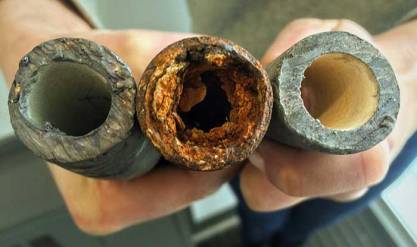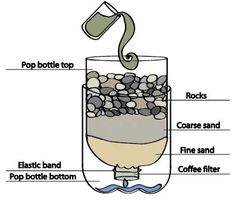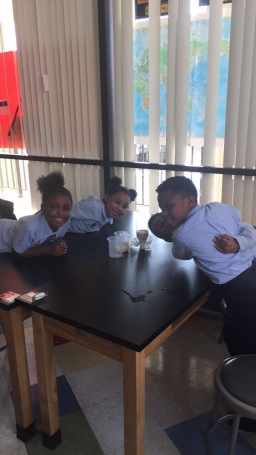By Ms. McByrd

The students came into class prepared to learn about the water filtration process. We began our lesson with a discussion of the different types of water that exist in the world: Freshwater and Saltwater.
Students were intrigued to know that currently, only 1 to 2% of water in the world is available for humans to consume. Students also were interested to learn that the water we consume is freshwater, not saltwater. Most students came into the classroom under the impression that we get our water from oceans.
After our discussion about water itself, we began to discuss issues with water quality and lead in water. Most of the students, because of their participation in Grassroots Campaign with Ms. Konibaje on Clean Water, knew about lead coming from corroded pipes and the damage it does to the human body.
Not only did they know, they cared about people’s access to healthy clean water.

I then asked students the big question “How do you think the issue of water quality can be solved?” Immediately hands shot up to discuss providing people with clean water, buying bottled water for people, and cleaning water ourselves.
Therein, our lab activity on water filtration began. I showed the class a large bottle of brown, dirty water. I asked students, “Would you believe me if I told you today, in this class, we are going to turn this water from brown and dirty to clear and clean?” Some students were skeptical, while others sat in agreement, but all were intrigued.
We started our water filtration process by beginning with aeration. I explained to students the process of aeration and had a student volunteer come up to shake the bottle about ten times for the aeration process. We then began our next step of the process: coagulation. I poured a small portion of the dirty, brown water into containers for each group of students. 
We took alum and stirred it into the water. Students were able to immediately explain the purpose of the alum (sticking to the dirt). Afterward, we waited for about twenty minutes for the alum and dirt to settle in the bottom of the container. While we waited, we began making our filters for the filtration step. Students used plastic water bottles with the bottom cut off, large rocks, small pebbles, sand, and a coffee filter to create their filters.

Once the filters were created, we tested them with clear water to make sure that water could get through completely. After making our filters, we returned to look at our alum filled water and students recognized the process of sedimentation. All the alum and heavier pieces of dirt settled to the bottom of the container.
The water was still brown, but students could see a visible difference. Students were now ready to begin the filtration process. Students slowly poured the dirty water into the top of their filter. After a few minutes, students could visibly see clear water dripping out the bottom end of their filters. Success!

I then posed the major question, “Is this clear, ‘clean’, water now safe for us to drink?” All the students immediately knew the answer was no.
They were able to explain, in detail, that the water could still have bacteria or particles too small to see.
They also mentioned the possibility of lead in the water. I explained to students that the process of disinfection is the next step to rid water of any other bacteria.
Providing students with a simplistic, hands-on view of the water process helped to contribute to the reality of a solution to their Grassroots Campaign.
Understanding the steps it takes, on a small scale, to achieve the goal of clean water helped to further student ideas around providing clean water as a simple solution.



Dear Ms. McByrd:
What an excellent article, and what a valuable lesson for your students. While not everything is a “social justice” issue per se–clean, safe and healthy water is certainly a “public health” concern. It’s pleasing to see your attention to this matter shared with your students…perhaps our future plumbers, scientists, and even legislators of tomorrow.
It was only until 1961 that the people in Calcutta, India, did not have proper water to drink or to use for dish and clothes washing–what we here in America take for granted. And there are still areas of the African continent that utilize water from nearby rivers–infested with bacteria, protozoans or parasites which cause dysentery, a disease of the lower intestine caused by infection and marked by severe diarrhea, inflammation, and the passage of blood and mucus.
And here in the United States, the state of Michigan had a water crisis just a year ago for which thousands of citizens in and around the Windsor county area–and specifically Detroit–were afflicted with not only bad water, but the unavailability of healthy water for several months. Clean and safe water had to be brought in from neighboring states to help the people with their needs and this crisis.
We are to remember the age-old saying: “Water is life–where there is water there is life.” And again, it is not a “social justice” issue–where one person or body of people decide who gets clean water and who does not. It’s a public health matter–whereby all humanity and all Americans must be concerned for the progress and wellness of others.
Congratulations to you, Ms. McByrd. You do your students and teaching profession proud. Teachers make all other professions possible, and teachers make our students not only smart, but good.
Continued success and blessings,
Rick Martinez